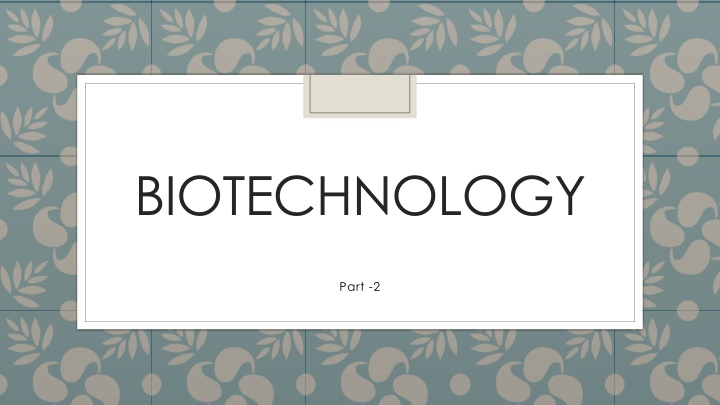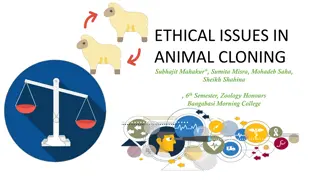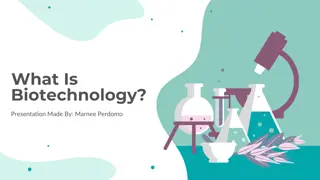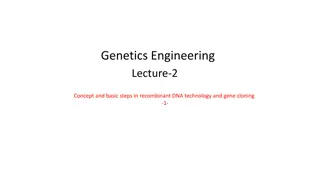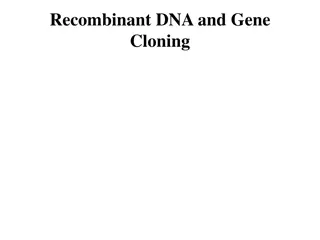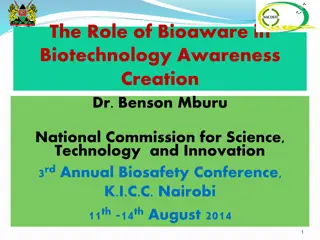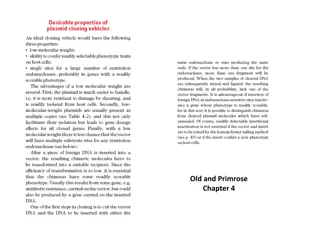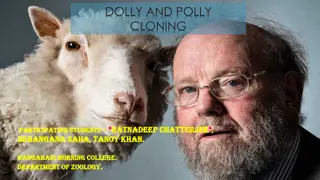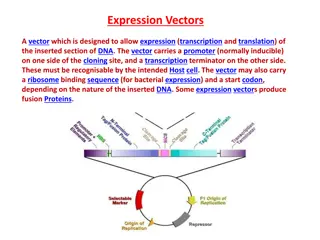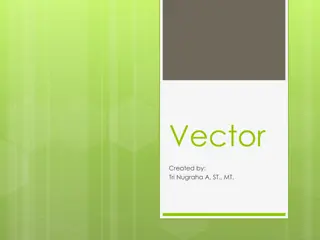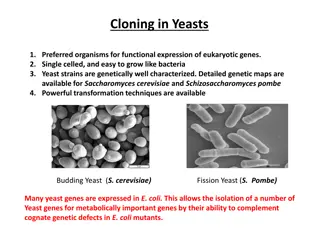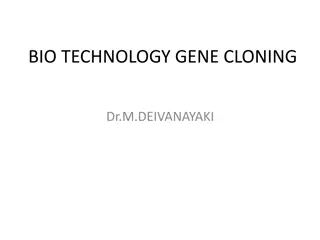Biotechnology
Biotechnology involves the use of vectors to replicate DNA molecules and integrate foreign genetic sequences. Vectors are classified into expression vectors for obtaining protein products and cloning vectors for generating copies of genes. Expression vectors enable gene expression through transcription and translation processes, while cloning vectors are used in gene libraries and require genetic modification to accommodate foreign DNA. Common vectors include plasmids, bacteriophages, yeast artificial chromosomes, and bacterial artificial chromosomes. Understanding the roles and types of vectors is crucial in biotechnology applications.
Download Presentation

Please find below an Image/Link to download the presentation.
The content on the website is provided AS IS for your information and personal use only. It may not be sold, licensed, or shared on other websites without obtaining consent from the author.If you encounter any issues during the download, it is possible that the publisher has removed the file from their server.
You are allowed to download the files provided on this website for personal or commercial use, subject to the condition that they are used lawfully. All files are the property of their respective owners.
The content on the website is provided AS IS for your information and personal use only. It may not be sold, licensed, or shared on other websites without obtaining consent from the author.
E N D
Presentation Transcript
BIOTECHNOLOGY Part -2
Vectors A vector is a DNA molecule that has the ability to replicate autonomously in an appropriate host cell and into which the gene of interest (a foreign genetic sequence) is integrated. When we insert a foreign genetic sequence into the vector the aim is either to obtain numerous copies of the gene of interest or to obtain the product of that. Accordingly the design and features of the vectors used for the assigned activity vary. Due to this there are two types of vectors the expression vectors and cloning vectors.
Expression Vectors We use an expression vector when our aim is to obtain the protein product of our gene of interest. To get the protein we need to allow the expression of our gene of interest (hence the name expression vector) by employing the processes of transcription and translation. Apart from the three DNA sequences discussed above (origin of replication, selectable markers and multiple cloning sites), the expression vectors have some special additional sequences as well.
Cloning vectors We use a cloning vector when our aim is to just obtain numerous copies (clones) of our gene of interest (hence the name cloning vectors). These are mostly used in construction of gene libraries. A number of organisms can be used as sources for cloning vectors. Some are created synthetically, as in the case of yeast artificial chromosomes and bacterial artificial chromosomes, while others are taken from bacteria and bacteriophages. In all cases, the vector needs to be genetically modified in order to accommodate the foreign DNA by creating an insertion site where the new DNA will fitted. Example: PUC cloning vectors, pBR322 cloning vectors, etc.
CLONING VECTOR Cloning vectors are also called Vehicles for Cloning. The vectors are DNA molecules that can carry a foreign DNA segment and replicate inside the host cell. Vectors may be Plasmids, Bacteriophage, Cosmids, Phagemid, Yeast Artificial Chromosomes (YACs), Bacterial Artificial chromosomes (BACs), Transposons or virus. Out of these vectors, plasmid vectors and bacteriophage vectors are commonly used.
Plasmid A plasmid is a small, extrachromosomal DNA molecule within a prokaryotic cell that can replicate independently. These were the first vectors used in gene cloning. These are found in bacteria, eukaryotes and archaea. These are natural, extrachromosomal, self-replicating DNA molecules. They have a high copy number and possess antibiotic-resistant genes. They encode proteins which are necessary for their own replication. pBR322, pUC18, F-plasmid are some of the examples of plasmid vectors
Bacteriophage These are more efficient than plasmids for cloning large DNA inserts. Phage and M13 phage are commonly used bacteriophages in gene cloning. 53 kb DNA can be packaged in the bacteriophage. The screening of phage plaques is much easier than the screening of recombinant bacterial colonies. A bacteriophage is a type of virus that infects bacteria. In fact, the word "bacteriophage" literally means bacteria eater," because bacteriophages destroy their host cells. All bacteriophages are composed of a nucleic acid molecule that is surrounded by a protein structure.
Cosmid Cosmid ( cos + plasmid ) Vectors. The term cosmid is a combination of two words, COS + MID. Cos sequences are 200 base pairs long nucleotide sequences that are recognized for packaging a phage DNA molecule into its protein capsule. COS is taken from COS site of Lambda phage and MID is taken from plasmid DNA. Cosmid was developed for the first time by Collins and Hons (1978). Cosmids can be used to clone DNA fragments upto 45 kb in length.
Phagemids Phagemid is a composite structure made of bacteriophage and plasmid. They are used for carrying larger DNA sequences. these are artificial vectors. They are used in combination with M13 phage. They possess multiple cloning sites and an inducible lac gene promoter. They are identified by blue-white screening
Yeast Artificial Chromosome (YAC) These are used to clone DNA fragments of more than 1 Mb Mega base pairs (106 bp) in size, therefore, they have been exploited extensively in mapping the large genomes, e.g, in the Human Genome Project. These vectors contain the telomeric sequence, the centromere and the autonomously replicating sequence from yeast chromosomes. They also contain restriction enzyme sites and genes which act as selectable markers in yeast.
Bacterial Artificial Chromosome (BAC) These are vectors based on natural, extra chromosomal plasmid of E. coli. These vectors can accommodate up to 300-350 kb of foreign DNA and are also being used in genome sequencing project. These are similar to E.coli plasmids vectors. It is obtained from naturally occurring F plasmid. These are used to study genetic disease . They can accommodate large DNA sequences without any risk.
Transposons or virus Transposons are units of DNA which can move from one DNA molecule to another hence are said to be mobile. They are also called transposable elements or mobile genes or jumping genes. Transposons were first observed by Barbara Mc Clintock (1951) in Maize plants.
